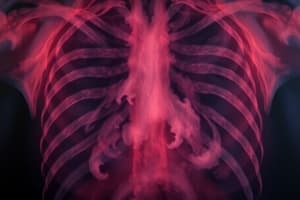Podcast
Questions and Answers
Which defect results from incomplete fusion of the endocardial cushions?
Which defect results from incomplete fusion of the endocardial cushions?
- Atrioventricular canal defect (correct)
- Ventricular septal defect
- Patent ductus arteriosus
- Atrial septal defect
What is the management approach for infants with severe symptoms of atrioventricular canal defect?
What is the management approach for infants with severe symptoms of atrioventricular canal defect?
- Cardiac catheterization
- Indomethacin administration
- Ventricular septal defect repair
- Pulmonary artery banding (correct)
What characteristic murmur is audible on auscultation in patients with patent ductus arteriosus?
What characteristic murmur is audible on auscultation in patients with patent ductus arteriosus?
- Systolic ejection murmur
- Pansystolic murmur
- Diastolic rumble murmur
- Continuous machinery-like murmur (correct)
Which medication is administered to close the defect in premature infants with patent ductus arteriosus?
Which medication is administered to close the defect in premature infants with patent ductus arteriosus?
What is the surgical method often used to repair complete atrioventricular canal defects?
What is the surgical method often used to repair complete atrioventricular canal defects?
Study Notes
Heart Defects and Treatment
- Incomplete fusion of the endocardial cushions results in Atrioventricular Canal Defect (AVCD)
- Infants with severe symptoms of AVCD are managed with aggressive medical therapy, including cardiotonic agents, diuretics, and correction of acid-base imbalance
- Patients with Patent Ductus Arteriosus (PDA) exhibit a continuous machinery-like murmur on auscultation
- Indomethacin is administered to premature infants with PDA to close the defect
- Complete AVCDs are often surgically repaired using the Two-Patch Method
Studying That Suits You
Use AI to generate personalized quizzes and flashcards to suit your learning preferences.
Description
Test your knowledge on cardiac defects causing increased pulmonary blood flow, focusing on atrioventricular canal defect and patent ductus arteriosus. Learn about the management options for these defects.




